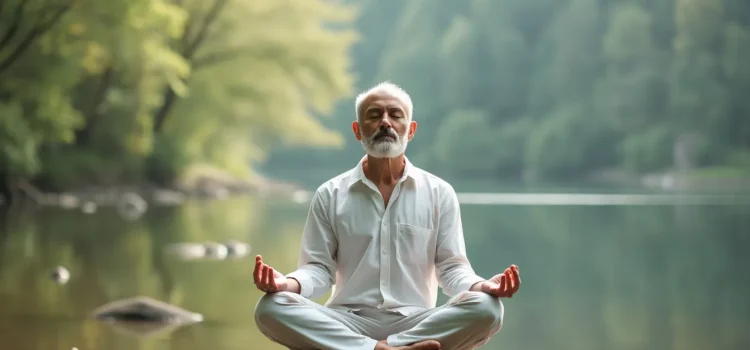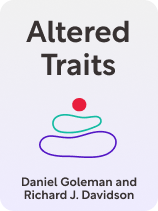

This article is an excerpt from the Shortform book guide to "Altered Traits" by Daniel Goleman and Richard J. Davidson. Shortform has the world's best summaries and analyses of books you should be reading.
Like this article? Sign up for a free trial here.
Is mindfulness meditation just for monks and spiritual seekers? Can everyday people benefit from this ancient practice?
In Altered Traits, Daniel Goleman and Richard Davidson explain how mindfulness has evolved from its traditional roots to become a popular tool for self-improvement. Today, people approach meditation through various paths, ranging from deep spiritual practices to casual stress relief techniques.
Keep reading to understand traditional and secular mindfulness approaches in the West.
Traditional & Secular Mindfulness
In its transition to the modern age and the Western world, mindfulness meditation has been reinterpreted and reformulated for many fields and uses. The authors explain that, today, Westerners approach meditation either through more traditional means or more secular means:
- Traditional mindfulness: You practice meditation as a way of life. You follow a time-honored path toward enlightenment, learning from a lineage of established teachers. Monks who take Buddhist vows and live in monasteries exemplify this path.
- Secular mindfulness: You take meditation more as a tool for worldly self-improvement outcomes, such as better mental and emotional health. For instance, an entrepreneur might practice mindfulness to focus and to regulate his stress.
(Shortform note: Writing on Buddhism’s transition to the West, David Chapman describes what he calls “Consensus Buddhism”—a more mainstream version of Buddhism designed to appeal to the liberal Western baby boomers (such as the authors). Resting between fully traditional and fully secular approaches, Consensus Buddhism drops cultural trappings, such as distinctly Indian cosmology and theology, but it keeps the emphasis on committed practice. Chapman also says that it subtly mixes traditionally Western ethics with Buddhism’s original ethical precepts, an approach that better suits many Westerners. If you meditate in a Western context, you might read more of the history of Western Buddhism to learn about your practice’s historical and intellectual heritage.)
Along these two paths, the authors describe five depths of meditative practice that gradually step out from the deep end of traditional practice and into the shallow but broad end of secular practice:
- The first depth is “pure” meditation, or meditative practice done in a traditional context such as a monastery. This is the deepest possible commitment to practice.
- The second depth is meditation pursued with a similar level of seriousness, yet practiced in a Western context for a Western audience.
- The third depth is meditation practiced seriously, but more for personal growth than spiritual liberation. Rather, the goal is practical gains—for instance, some people meditate to improve their cognition and therefore become more productive.
- The fourth depth is meditation taken less seriously, used more as a “life hack” than a regular practice. For example, many people use apps or guided meditation videos to get a dose of mindfulness in a more ad hoc way and for purposes like stress relief.
- The fifth depth is speculative—the authors suggest that meditation technologies may become more democratically accessible, such that anyone can freely get meditation guidance on their phone at any time.
| How Might You Practice at Each Depth? If you’re interested in practicing meditation at any of these depths, here are some ways you could get started: • To practice at the first depth, you might seek training or instruction in a traditional monastic setting, such as one in the Thai Forest Tradition. • To practice at the second depth, you might go to a modern Buddhist monastery in the West, like the Monastic Academy for the Preservation of Life on Earth (MAPLE). • To practice at the third depth, you might follow a secular mindfulness program like that outlined in Wherever You Go, There You Are by Jon Kabat-Zinn or 10% Happier by Dan Harris. • To use fourth-depth tools, you could download an app like Headspace or explore the many free guided meditations on YouTube. Wherever you start, go slow and trust your intuition. There’s no shame in exploring shallower paths or in finding that committed monastic practice isn’t for you. And, fortunately, you can reap many benefits—like improved focus and mental clarity—from a simple, secular habit of daily mindfulness. |
According to the authors, practicing meditation through traditional means, with a deep level of commitment, gives the most profound results. This would correspond to the first and second depths above. In the authors’ view, these more authentic ways to meditate provide the most compelling benefits, such as lasting changes to your brain that increase your capacity for compassion, selflessness, and tranquility.
In contrast, secular means (the third, fourth, and fifth depths) offer accessible benefits to more people. After all, not everyone is able to commit to a monastic lifestyle in a traditional Buddhist setting. However, secular mindfulness tools often overpromise their benefits. For example, an app won’t solve all your mental health challenges (as some marketing might imply)—but it might, as the authors say, provide some shallower positive gains.
(Shortform note: To better understand the tradeoffs of the profound results of traditional means versus the accessible benefits of secular means, take these real-world examples of each. First, traditional monastic settings can be comparatively inaccessible: For instance, a residency at MAPLE, mentioned above, can cost almost $3,000 monthly and may require that you don’t work. Then, secular ways of meditating—apps like Headspace or Calm—can misrepresent promised outcomes. Some argue that the notion of selling meditation benefits as worldly gains fundamentally misses the point that the Buddha tried to make.)
Exercise: Plan How You Might Meditate
In this exercise, consider the authors’ description of the different depths of meditation practice, their benefits, and how you might work a meditation practice into your life.
- First, consider how seriously you might want to meditate. Are you interested in committed spiritual seeking through traditional means, or do you have more practical goals (achievable through secular means)?
- What benefits do you hope to gain from a meditation practice? For instance, you might want to improve your focus or practice compassion.
- Based on how seriously you want to meditate and the benefits you hope to gain, what style or method could you start with? Keep in mind that different forms of meditation yield different outcomes, such as how loving-kindness meditation is best for developing prosocial emotions.
- When could you take some time to start meditating? Remember that even ten minutes a day can yield benefits. For example, you might carve out time for a brief session in the evening, after dinner.

———End of Preview———
Like what you just read? Read the rest of the world's best book summary and analysis of Daniel Goleman and Richard J. Davidson's "Altered Traits" at Shortform.
Here's what you'll find in our full Altered Traits summary:
- How the West has distorted true meditation
- Why meditation is so difficult to study
- The 5 proven benefits of having a meditation practice






